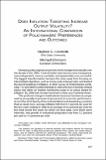| dc.contributor.author | Cecchetti, Stephen G. | |
| dc.contributor.author | Ehrmann, Michael | |
| dc.date.accessioned | 2019-11-01T00:01:15Z | |
| dc.date.available | 2019-11-01T00:01:15Z | |
| dc.date.issued | 2002 | |
| dc.identifier.isbn | 956-7421-099 | |
| dc.identifier.uri | https://hdl.handle.net/20.500.12580/3657 | |
| dc.description | Monetary policy regimes around the world changed dramatically over the decade of the 1990s. Central banks have become more transparent, more independent, more accountable, and (apparently) more successful. The biggest transformation has benn the move away from focusing on intermediate objectives, susch as money and exchange rates, and toward the direct targeting of inflation. | |
| dc.format | .pdf | |
| dc.format.extent | Sección o Parte de un Documento | |
| dc.format.medium | p. 247-274 | |
| dc.language.iso | eng | |
| dc.publisher | Banco Central de Chile | |
| dc.relation.ispartof | Serieson Central Banking, Analysis, and Economic Policies, no. 4 | |
| dc.rights | Attribution-NonCommercial-NoDerivs 3.0 Chile | * |
| dc.rights.uri | http://creativecommons.org/licenses/by-nc-nd/3.0/cl/ | * |
| dc.subject | INFLACIÓN | es_ES |
| dc.subject | POLÍTICA ECONÓMICA | es_ES |
| dc.subject | BANCOS CENTRALES | es_ES |
| dc.title | Does inflation targeting increase output volatility?: an international comparison of policymakers' preferences and outcomes | |
| dc.type.doc | Artículo | |
| dc.file.name | BCCh-sbc-v04-p247_274 | |


